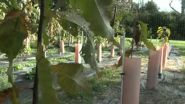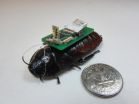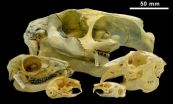(Press-News.org) Berlin, Germany (November, 2014) – A specimen of the ancient horse Eurohippus messelensis has been discovered in Germany that preserves a fetus as well as parts of the uterus and associated tissues. It demonstrates that reproduction in early horses was very similar to that of modern horses, despite great differences in size and structure. Eurohippus messelensis had four toes on each forefoot and three toes on each the hind foot, and it was about the size of a modern fox terrier. The new find was unveiled at the 2014 Annual Meeting of the Society of Vertebrate Paleontology in Berlin.
"Almost all of the bones of the fetus are still articulated in their original position. Only the skull is crushed," said Dr. Jens Lorenz Franzen of the Senckenberg Research Institute, lead author of the study. The study's co-authors are Dr. Jörg Habersetzer, also of the Senckenberg Research Institute, and Dr. Christine Aurich of the University of Veterinary Medicine at Vienna and head of the Graf Lehndorff Institute of Equine Sciences.
The specimen was discovered by a team from the Senckenberg Research Institute nearly 15 years ago, but its extent was not fully appreciated until it was studied using micro x-ray. The micro x-ray analysis revealed a structure known as the broad ligament that connects the uterus to the backbone and helps support the developing foal. Remnants of the wrinkled outer uterine wall became visible after the specimen was prepared, a feature shared between Eurohippus and modern horses. The placenta in this specimen is only the second one that has been described for a fossil placental mammal.
The oil shales at Grube Messel have long been known for their marvelous fossils. These oil shales formed at the bottom of ancient Lake Messel and preserve the remains of mammals, birds, and other animals that were living near what is now Darmstadt, Germany about 47 million years ago (the Eocene epoch). No oxygen was present at the bottom of the lake when the dead animals sank down and finally became embedded in the muddy sediments. There, anaerobic bacteria immediately began to decompose skin, muscles, and other soft tissues. As a result, the bacteria produced carbondioxid, which in turn precipitated iron ions present in the lake water. In this way, the bacteria petrified themselves, developing only a very thin bacterial lawn depicting the soft tissue as black shadow. Consequently, Messel fossils preserve these remains not directly, but as images.
The size of the fetus and the presence of fully developed milk teeth indicate that it was close to term when it and its mother died. Nevertheless, its position in the uterus indicates that the two did not die during the birthing process. The fetus was upside down rather than right side up, and its front legs were not yet extended as they should be just before birth.
INFORMATION:
About the Society of Vertebrate Paleontology
Founded in 1940 by thirty-four paleontologists, the Society now has more than 2,300 members representing professionals, students, artists, preparators, and others interested in VP. It is organized exclusively for educational and scientific purposes, with the object of advancing the science of vertebrate paleontology.
Society of Vertebrate Paleontology website: http://www.vertpaleo.org
Journal of Vertebrate Paleontology
The Journal of Vertebrate Paleontology (JVP) is the leading journal of professional vertebrate paleontology and the flagship publication of the Society. It was founded in 1980 by Dr. Jiri Zidek and publishes contributions on all aspects of vertebrate paleontology.
Journal Web site: http://vertpaleo.org/Publications/Journal-of-Vertebrate-Paleontology.aspx
AUTHOR CONTACT INFORMATION
DR. LORENZ FRANZEN
Senckenberg Research Institute at Frankfurt am Main
Germany
0151-16580413 (cell)
jfranzen@senckenberg.de
DR. JÖRG HABERSETZER
Senckenberg Research Institute at Frankfurt am Main
Germany
jhaberse@senckenberg.de
DR. CHRISTINE AURICH
University of Veterinary Medicine at Vienna (Austria)
Head of the Graf Lehndorff Institute of Equine Sciences at Neustadt (Dosse; Germany)
Christine.Aurich@vetmeduni.ac.at
OTHER EXPERTS NOT ASSOCIATED WITH THE STUDY
BRUCE MACFADDEN
Florida Museum of Natural History
bmacfadd@flmnh.ufl.edu
KEN ROSE
Johns Hopkins University
kdrose@jhmi.edu
Exquisite ancient horse fossil preserves uterus with unborn foal
2014-11-06
ELSE PRESS RELEASES FROM THIS DATE:
Blight-resistant American chestnut trees take root at SUNY-ESF
2014-11-06
VIDEO:
Scientists at the SUNY College of Environmental Science and Forestry (ESF) are growing the first American chestnut trees that can withstand the blight that virtually eliminated the once-dominant tree from...
Click here for more information.
SYRACUSE, N.Y. — Scientists at the SUNY College of Environmental Science and Forestry (ESF) are growing the first American chestnut trees that can withstand the blight that virtually eliminated the once-dominant tree from the eastern ...
Study shows why cliques thrive in some schools more than in others
2014-11-06
WASHINGTON, DC, November 6, 2014 -- Go to almost any American high school and the elements of teen social networks become quickly apparent: the cliques, the pecking orders, and the varying degrees of self-segregation by race, age, gender, and social status.
For years, sociologists have identified seemingly universal human instincts that spur this kind of sorting. These include the desires for familiarity and certainty; for control and dominance; and for security and support.
But as ubiquitous as those instincts are, students in some schools form more cliquish, hierarchical, ...
Cockroach cyborgs use microphones to detect, trace sounds
2014-11-06
North Carolina State University researchers have developed technology that allows cyborg cockroaches, or biobots, to pick up sounds with small microphones and seek out the source of the sound. The technology is designed to help emergency personnel find and rescue survivors in the aftermath of a disaster.
The researchers have also developed technology that can be used as an "invisible fence" to keep the biobots in the disaster area.
"In a collapsed building, sound is the best way to find survivors," says Dr. Alper Bozkurt, an assistant professor of electrical and computer ...
Tricky take-off kept pterodactyls grounded
2014-11-06
Berlin, Germany (November, 2014) – A new study, which teamed cutting-edge engineering techniques with paleontology, has found that take-off capacity may have determined body size limits in extinct flying reptiles. The research simulated pterodactyl flight using computer modeling, and will be presented at the upcoming Society of Vertebrate Paleontology meeting in Berlin. Findings suggest that a pterodactyl with a wingspan of 12m or more would simply not be able to get off the ground.
Pterosaurs (commonly known as pterodactyls) were truly giants of the sky. With ...
Revolutionary ALMA image reveals planetary genesis
2014-11-06
For ALMA's first observations in its new and most powerful mode, researchers pointed the antennas at HL Tauri — a young star, about 450 light-years away, which is surrounded by a dusty disc [1]. The resulting image exceeds all expectations and reveals unexpectedly fine detail in the disc of material left over from star birth. It shows a series of concentric bright rings, separated by gaps [2].
"These features are almost certainly the result of young planet-like bodies that are being formed in the disc. This is surprising since such young stars are not expected to ...
Birth of planets revealed in astonishing detail in ALMA's 'best image ever'
2014-11-06
Astronomers have captured the best image ever of planet formation around an infant star as part of the testing and verification process for the Atacama Large Millimeter/submillimeter Array's (ALMA) new high-resolution capabilities.
This revolutionary new image reveals in astonishing detail the planet-forming disk surrounding HL Tau, a Sun-like star located approximately 450 light-years from Earth in the constellation Taurus.
ALMA uncovered never-before-seen features in this system, including multiple concentric rings separated by clearly defined gaps. These structures ...
Cellular extensions with a large effect
2014-11-06
Tiny extensions on cells, cilia, play an important role in insulin release, according to a new study, which is published in Nature Communications. The researchers report that the cilia of beta cells in the pancreas are covered with insulin receptors and that changed ciliary function can be associated with the development of type 2 diabetes.
Cilia are tiny extensions on cells and they are credited with many important functions, including transduction of signals in cells. Defects in cilia have been implied in several diseases and pathological conditions. Thus, scientists ...
Zebrafish stripped of stripes
2014-11-06
VIDEO:
A 10-day-old zebrafish gets its stripes over the next 30 days, one image taken a day.
Click here for more information.
Within weeks of publishing surprising new insights about how zebrafish get their stripes, the same University of Washington group is now able to explain how to "erase" them.
The findings – the first published Aug. 28 in Science and the latest in the Nov. 6 issue of Nature Communications – give new understanding about genes and cell behaviors ...
Rabbit-proof hoof: Ungulates suppressed lagomorph evolution
2014-11-06
Berlin, Germany (November, 2014) – Closely related groups can differ dramatically in their diversity, but why this happens is a fundamental question in evolutionary biology, dating back to Darwin's observation that a few hyper-diverse groups dominate the modern biota. One of the most extreme examples of this observation is found in the comparison of rodents (Rodentia) and rabbits (Lagomorpha). These two mammalian orders are sister groups, but while rodents have diversified to over 2000 living species and an enormous range of body sizes, lagomorphs (rabbits, hares, ...
Orange is not the new black: Just highly allergenic for one toddler
2014-11-06
ATLANTA, GA (November 7, 2014) – Many people don't realize allergies and asthma go hand-in-hand, and about 90 percent of kids with asthma also have allergies. Even more important, when asthma is undiagnosed or poorly controlled, children are at risk for suffering difficult-to-treat allergic reactions to food.
According to a study presented at the American College of Allergy, Asthma and Immunology (ACAAI) Annual Scientific Meeting, a two and-a-half year-old girl in Pennsylvania suffered a life-threatening allergic reaction (anaphylaxis) to eating an orange – ...






